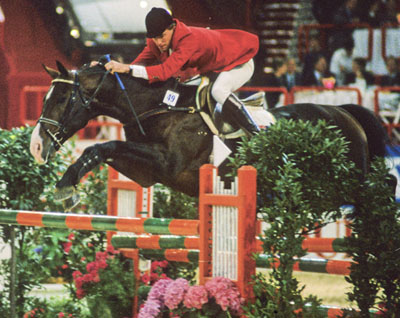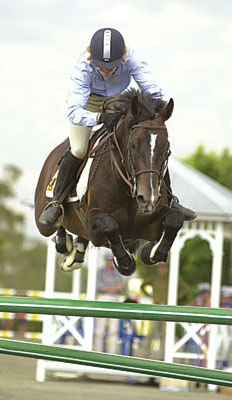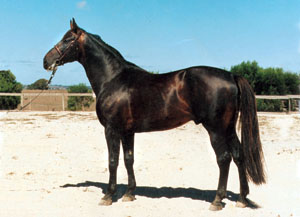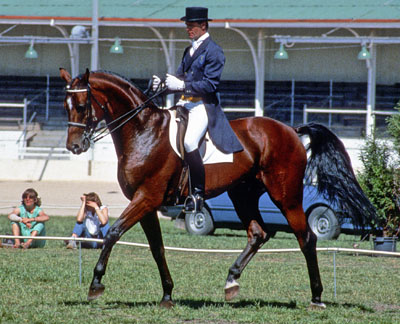
Sky High at the World Cup final in Gothenburg
One interesting development in the 40 years since Flaneur arrived, has been the discovery by Australian showjumping riders that while every now and then an ex-racehorse would prove to be a super showjumper, there were hundreds, perhaps thousands of others that didn’t make the grade. Australian jumping riders have realised that they need purpose-bred horses of established jumping lines, to be competitive on the international stage.
The stallion, Sky High was one of the first to make a mark. Sky High, along with his full-brother, Skies Above was imported from the UK by Chris Howe. He was eventually acquired by one of the early performance horse breeders, Bev Chugg – now Bev Edwards of Jaybee fame – and ridden by her son, Chris.
According to Bev: “About 1977, I started to look at the Warmbloods. I decided I wanted a Hanoverian, and one with a Ferdinand background.”
“Then the phone rang one night and it was Vin Cummins from Shepparton who was a good friend of mine. He said do you want a Hanoverian stallion? What is it? By Ferdi by Ferdinand – there we go, the little fairy on Beverly’s shoulder again. I’m very lucky, I always seem to fall into exactly the horse I want.”
“Chris Howe had imported the horse and he was looking for somebody to take him on. Vin had broken him in – sort of – he could do a bit of this and a bit of that. They were old-fashioned gentlemen, Vin and Chris – you did business on a handshake. I took the horse home and my son Chris said, what is that? I said, I’ll ride him, which I did, and frustrated myself for 12 months, because you had to hit it with a whip every stride to get it to trot. Finally I said to Chris, ‘what does this horse need?’ He said let me have a try, took the horse over and went from there…”
The chunky stallion was a tough competitor, and won the right to represent Australia at the World Cup final in 1987. The following year, Sky High won an Australian Showjumping Championship. As a sire, Sky High has been a more than respectable producer – with World Cup competitors: Heza Skyhawk, Diamond B Ego, OT Flying High and Jaybee Schultz. Add to that a few other handy progeny sold overseas: Sky High 2, and Albrudee High Star, and exported grand-children, Southern Jester and Penrose Park Witchetty Grub. Sky High was the inaugural THM Jumping Stallion of the Year in 2002.
Although Chugg’s next World Cup Final ride was on an unraced Thoroughbred, Mr Currency (once again discovered by his mother), he and his wife, Helen – in partnership with Mike Barrera (whose daughter, Michelle, rode internationally for the Philippines) put together one of the most exciting jumping breeding programs in the country.
Their company, Australian Sporthorse Breeders between 1999 and 2006 imported 17 horses as part of their breeding program. One of the first was the Belgian stallion, Vivant (Fuego du Prelet out of a mare of Landgraf breeding) imported in 1999. Since then he has come through the ranks in spectacular fashion, and last year took out Australia’s richest showjumping competition, the Grand Prix at Elysian Fields – and he is first reserve in the team for the Hong Kong Games.
Since then, Australian Sporthorse Breeders have imported the mares: Alondra, (Indorado / Emilion), Quintana (Heartbreaker / Randel Z) and Isis van Herikhave (Burggraaf / Paladin des Ifs), all arriving in 1999; Baluna (Kannan / Zeus), Briglace (Cardento / Heartbreaker), Colthaga (Colman / Barnaul), Galaxie Piereville (Jalisco / Grand Veneur), Miss Platiere (Verdi / Papillon Rouge), Altes van Beekveld (Darco / Voltaire), all arriving in 2004 and the 2005 arrivals: Chinaria (Chin Chin / Cassini I), Indira (Heartbreaker / Burggraaf), Sommerwind (Caretino / Ramiro Z) and the stallions: Conquistador (Clinton / Heartbreaker) in 2004, Quindoctro (Indoctro / Heartbreaker) in 2005 and Caracas (Cassell / Colman) who arrived in 2006.

Chris Chugg’s travelling companion on that trip to the 1987 World Cup final was Vicki Roycroft who had always been one of the showjumping riders who proclaimed the superiority of the Thoroughbred over the ‘Dumb-blood’. After competing at the World Cup final riding her Australian Thoroughbred, Apache, Vicki went on to win the Grand Prix of Rome, but ten years later, her views were changing. In 1998 she took over the ride on the Noblewood stallion, Jadalco (Fabio / Landgraf / Cor de la Bryère), and won a World Cup Qualifier on him. He was soon after exported to the USA but the Australian rider had got the message. Before too long Vicki was riding her own German import, Luna Luna (Oldenburg branded, by the Holsteiner, Landadel), the mare that took her to the WEG in Jerez in 2002.
Since then, Vicki’s conversion to the Warmblood has been complete and all her team are European jumping bred.
Vicki competed successfully on the World Cup circuit with the stallion, Premier des Hayettes (imported in 1999) – a brilliantly bred horse, being by Concorde, the best son of Voltaire, and out of Calbonny (Nimmerdor / Almé). Calbonny is also the dam of international jumping star, Mozart des Hayettes.
Vicki competed at World Cup level with Copabella Stud’s spectacular coloured stallion, Copabella Visage. Of Belgian / German breeding, Visage (in Europe, Visage van de Olmenhoeve) was purchased in France in 2003, and continues to send his (frozen) semen back to mare owners in that country.
The Copabella Stud is owned by Lesley and Alan Hargreaves and their daughter, Julia has now taken the ride on Visage, with considerable success. The Hargreaves family also contributes to the current revival of the jumping scene by running a very very classy boutique jumping show, the Copabella Classic.
In January 2005, Copabella imported the Selle Français mare, Holland Rose, in foal to Chin Chin (it was a colt!) and later that year, the Holsteiner mare, Cascavel (by Cantus) who is being used in an embryo transplant program while continuing her competition career.
George Sanna took the first Australian bred Warmblood to an Olympic Games – EBA Schnapps (by Duellschütz) to Seoul in 1988, before the horse was sold to the USA. Since then, despite his professed ignorance of the intricacies of European jumping breeding, George – along with his one-time EBA partners, Rod Brown and John MacMillan – has had quite a lot to do with the development of the jumping Warmblood in Australia.
Both Rod and George competed on EBA Spectre who was by one of the early imported stallions – Abel Tasman.
While partners, the three imported the Trakehner jumping stallion, Trak, from Poland in 1990. In the early days of EBA, they had employed a young Polish guy, Tom Umiatovski. “Tom the Pole, we called him. He knew his way around a horse, and he was with us for about six months,” George remembers.
George was in Stockholm for the WEG in 1990 where he competed in the Australian showjumping team with Westend Evita. There he met up with Tom again and travelled with him to Poland to look at horses.
“It was after Stockholm I went to the Stud with Tom. I was pretty impressed and decided we should buy a stallion, there were 200 to 300 stallions, so I decided we’d buy a five or six year old. The only trouble was that they were all dark brown and they had 10-15 stable riders, I was standing in the middle with these batches of ten going round and round in a circle popping over this one jump one after another – six strides apart. And I’m trying to get a bloody handle on these horses!”
Eventually he made his choice – Trak.

“He arrived in Australia about six months later and we were very enthusiastic about him, but shortly after he arrived, Rod (Brown) was riding him down to the arena, and he did a big stallion rear, squeal and spin, and he lost his footing. He did the splits behind and fell over and he was never sound after that, not crippled, but just not right behind – so off he went to become a breeding stallion, something we’d never intended getting into, we set out to buy a jumper.”
As a sire, Trak has been more than useful but with limited opportunities, again, according to George: “I think he was really under-utilised, which is a pity because I’ve hardly seen one that can’t jump. I don’t think he ever got the big opportunities that a lot of the fancy stallions had. That horse of Melissa Moore’s Triple Treat, that’s a very fancy horse, but you see them all the time, even when they don’t have very good riders, they all jump.”
Trak was named THM Jumping Stallion of the Year in 2006. But George was to go on to much bigger Warmblood projects. One of George’s star pupils is Emily Blinkworth, and Emily has been supported to the max by her parents, Charles and Gail. They took her shopping, with George as advisor, to Europe’s fanciest jumping barn – Stal Tops, in Holland.
In 2003, CP Argentina (Chiron / Graf Dagobert) was imported to Australia, and she has been the most wonderful horse for Emily. Together the pair were the NSW Young Rider champions of 2003 and 2004, the 2006 Australian Young Rider Champions, and in 2005 they won the Sydney CDI Grand Prix. Since then the Blinkworths have imported more breeding stock, like the mare, CP Aprilla (Heartbreaker / Pachat) also in 2003, and in 2006, three horses, the mare, CP Quintana (Quintus / Opium de Lauby), and the stallions CP Qualified (Quite Capitol / Corofino) and CP Ulixes (Lux / Jasper).
Once again, here we have an owner / breeder who also supports the sport on the competition scene. Charles has been Number One sponsor of Australia’s most prestigious jumping competition, the Tempo, now the ISS, show – and he shows no signs of stopping importing super horses from Europe.
The May 2001 edition of THM featured the first ever Jumping Breeders Special. At the time my fellow workers on the magazine thought I was mad, there was not enough interest in breeding jumping horses to make a special, they swore. But it arrived, 22 pages long and since then the Jumping special – like jumping breeding in this country – has gone from strength to strength.
But again, we are getting in front of ourselves, time to zip back to Victoria and another key player in the Warmblood scene…
Dressage and the Warmblood
Gert Donvig came to Australia from Denmark in the early 70’s to work at the famed Victorian Thoroughbred stud, Stockwell, where he spent two years. At Oaklands Hunt Club he met his wife-to-be, Mary, and started riding again. In 1976, they imported their first stallion from Denmark, Kilof McOhl – and immediately set about showing Australian equestrian fans what this new fangled Warmblood breed could do!
Lucinda Green hunted Kilof around the Gawler Intermediate track in 1982, finishing in 9th place, after being way in front after a dressage score of 45.2. (The next best was another imported stallion, this time the Trakehner, Königsberg, ridden by John Patterson on 51.2. After a good cross country round, Königsberg was withdrawn before the third day.)
Mary starred with Kilof McOhl at Prix St Georges level in the Haig Cup, while Gert amazed the crowds at Melbourne’s Royal Show riding Kilof in just the spotlight’s circle of light on an otherwise pitch black arena.
In an interview in THM Gert explained his breeding strategy:
“We selected Kilof because we were aware that Aussies were Thoroughbred oriented, and it would have been a flop to import a horse like Wunder then. I looked for a smaller lighter horse, with quality. Then came Granada who had even more movement and who was even more Thoroughbred… We obtained quality stock with Kilof and Granada but we didn’t always get the height. With Valuta we seem to be getting the quality and the height. My ideal Warmblood has a little more bone than the Thoroughbred but still has the temperament and the action.”
In 1979 Gert and Mary had imported another Danish Warmblood, Granada, followed by two more, Valuta in 1982, and Wunder in 1986.
Granada went to Prix St Georges (and sired Grand Prix competitors in Grand Espoir and Northern Greta) but had a flying change block that not even a season in Germany with ‘Bimbo’ Peilicke could undo, and he was eventually sold to Indonesia. Wunder had soundness problems and never really got going but Valuta was a star!

The Danish Trakehner, Valuta was one of the first horses to compete at Grand Prix level and look comfortable and stylish. At the 1986 Australian Dressage Championships, only two of the Grand Prix horses were willing to tackle the Grand Prix Special, Judy Dierks on her Thoroughbred, Galoubet and Gert and Valuta. The pair competed for a bottle of whisky, which Judy narrowly won, but history had been made – our first Special had been ridden.
In 1988 Valuta and Gert were long listed for the team to the Seoul Olympics, but in the end Australia was represented by a single individual, Erica Taylor and her Thoroughbred stallion, Crown Law.
Sadly Gert died a young man in 1988, but his wife Mary, now Hanna, keeps the stud going and continues to compete at the highest level – while their daughter, Gitte Donvig, is also an FEI dressage competitor.
I believe it was the riders’ demand for a competitive performance horse that saved the Warmblood from the fate that seems to befall all breeds and breed societies, and that is the tendency to celebrate the worst features of the type as a ‘breed characteristic’. Thus instead of trying to breed out a choppy winging trot, the Andalusian true believers celebrated it. As the Arabian horse got more and more artificial and ‘chocolate box’ pretty, the breeders hailed the ‘breed type’. I have no doubt that left in the hands of the sort of people who tend to cluster around breed societies, the Warmbloods would have become bigger, uglier, clumsier and more useless – what saved them from becoming ‘elephants’ was the riders who took them out into competition and learnt to reject the ones who couldn’t do the job…
Next month – the establishment of the NSW Equestrian Centre, and two new breeds, the Hanoverian and the Trakehner…



Have to say, I had a Kilof, out of a TB mare, he made 17.3hh! Black, best horse ever.
i have a Kilof McOhl Mare and granddaughter and have just bred a half grandson of Kilof Mcohl they all having amazing temperaments and lovely movement with sense and trainability. Love this bloodline
I have a 28 year old Kilof son who reached advanced dressage. Lovely movement. He went to rda at the age of 22 and came back to me last year and is now going to pony club where he is the star of the show!